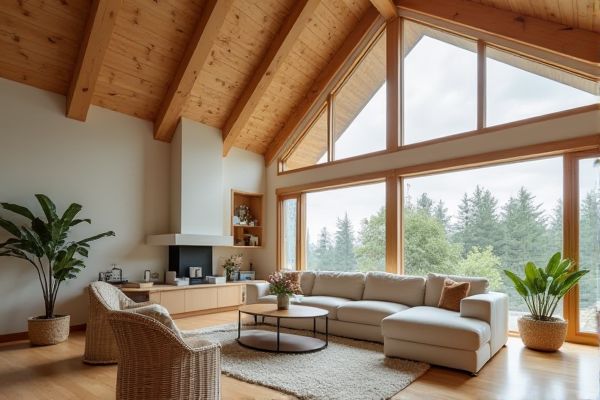
Rafter tail design showcases exposed rafters extending beyond the roofline, creating a traditional, decorative appearance while boxed eaves conceal these rafters within a clean, enclosed soffit for a streamlined look. Understanding the differences between these eave styles can help you choose the best option for Your home's aesthetic and maintenance needs; read on to explore their unique benefits.
Table of Comparison
| Feature | Rafter Tail Design | Boxed Eaves |
|---|---|---|
| Appearance | Exposed rafter ends, rustic look | Enclosed, clean, modern finish |
| Maintenance | Requires regular painting and cleaning | Less maintenance, protected from elements |
| Ventilation | Better natural ventilation via open tails | Needs vent installation for airflow |
| Protection | Less protection to roof framing | Better protection against weather and pests |
| Cost | Lower initial cost, simpler construction | Higher cost due to additional materials |
| Installation | Faster, less complex | More labor-intensive, complex installation |
| Design Flexibility | Limited to traditional styles | Compatible with various styles and materials |
Introduction to Rafter Tail Design and Boxed Eaves
Rafter tail design showcases exposed rafter ends that extend beyond the roofline, offering distinctive architectural character and enhanced ventilation for your home's eaves. Boxed eaves enclose the rafter tails within a soffit and fascia system, providing a clean, finished look that protects against pests and weather damage. Selecting between rafter tail design and boxed eaves impacts the aesthetic appeal, maintenance needs, and airflow management of your roofing structure.
Aesthetic Differences: Exposed Rafter Tails vs Boxed Eaves
Exposed rafter tails create a rustic, traditional aesthetic by showcasing the structural elements of a roof, adding character and architectural interest to your home. Boxed eaves offer a clean, streamlined appearance by enclosing the rafter tails, often preferred in modern and minimalist designs for their neat finish. The choice between these styles impacts the overall curb appeal and visual texture of your property.
Structural Considerations and Load Bearing
Rafter tail design exposes the ends of rafters beyond the wall line, allowing for efficient water runoff and ventilation but requires careful attention to the structural integrity and load distribution on the overhanging section. Boxed eaves enclose the rafter tails within a soffit, providing additional protection from weather while offering a more rigid framing system that evenly distributes roof loads to the wall structure. Structural considerations emphasize that rafter tails must be adequately supported to prevent sagging or damage, whereas boxed eaves can enhance load-bearing capacity by integrating with the wall framing and reducing stress on individual rafters.
Material Choices for Each Eave Style
Rafter tail design typically utilizes exposed wood, such as cedar or redwood, to highlight natural grain and aesthetic appeal, while boxed eaves often incorporate materials like vinyl or aluminum soffits and fascia for durability and low maintenance. Wood rafter tails may require regular sealing and painting to prevent weather damage, whereas boxed eaves benefit from integrated ventilation systems that protect roof structures and improve energy efficiency. Selecting the right material depends on desired architectural style, climate exposure, and long-term maintenance considerations.
Energy Efficiency: Ventilation and Insulation
Rafter tail design enhances energy efficiency by allowing continuous ventilation along the roofline, preventing moisture buildup and promoting better airflow that helps regulate attic temperatures. Boxed eaves provide a more enclosed structure, which can simplify insulation installation but may require additional vents to maintain adequate attic ventilation and prevent heat accumulation. Your choice between rafter tails and boxed eaves directly impacts ventilation effectiveness and insulation performance, influencing overall energy savings and indoor comfort.
Maintenance Requirements and Longevity
Rafter tail design exposes the ends of rafters, requiring regular maintenance to prevent weather damage, insect infestation, and wood rot, which can reduce longevity without proper care. Boxed eaves enclose the rafters, offering better protection from the elements and minimizing maintenance needs, thus extending the roof's lifespan. You can enhance durability and reduce upkeep by choosing boxed eaves for a more weather-resistant, long-lasting exterior finish.
Cost Comparison: Installation and Upkeep
Rafter tail designs generally have lower installation costs due to their simpler construction, while boxed eaves require more materials and labor, increasing initial expenses. In terms of upkeep, rafter tails demand regular maintenance to prevent weather damage and insect infestation, a factor that can raise long-term costs. Your choice between the two should weigh immediate budget constraints against ongoing maintenance commitments.
Climate Impact and Weather Resistance
Rafter tail design enhances natural ventilation and allows for better airflow, reducing moisture buildup and mitigating the risk of mold in humid climates. Boxed eaves provide superior protection against heavy rain and snow by fully enclosing the roof overhang, preventing water infiltration and wind-driven debris damage. Choosing between these options depends on balancing ventilation needs with the severity of local weather conditions to optimize durability and energy efficiency.
Popular Architectural Styles Featuring Each Design
Rafter tail designs are prominently featured in Craftsman, Tudor, and Mediterranean architectural styles, where exposed wood beams and decorative details enhance the rustic or historic aesthetic. Boxed eaves, which conceal the rafters for a cleaner, streamlined look, are commonly found in Colonial, Contemporary, and Ranch-style homes emphasizing simplicity and modernity. Each design complements specific architectural movements by either showcasing structural elements or promoting minimalistic exterior lines.
Choosing the Right Eave Style for Your Home
Rafter tail design showcases exposed rafters that add rustic charm and architectural character to your home, enhancing curb appeal while allowing easy ventilation and maintenance access. Boxed eaves provide a clean, finished look by enclosing the rafters, offering better protection against pests and weather damage, making them ideal for homes requiring a streamlined aesthetic and added durability. Your choice between these eave styles should consider factors like desired visual appeal, climate, and maintenance preferences to optimize both function and style.
 homyna.com
homyna.com